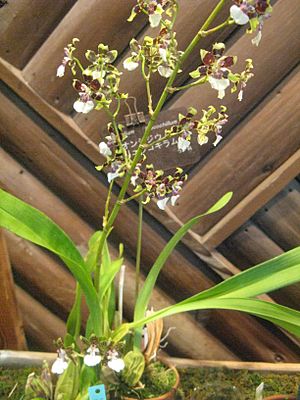Oncidium leucochilum facts for kids
Quick facts for kids Oncidium leucochilum |
|
|---|---|
 |
|
 |
|
| Illustration by Sarah Ann Drake | |
| Scientific classification | |
| Genus: |
Oncidium
|
| Species: |
leucochilum
|
| Synonyms | |
Oncidium leucochilum (say: on-SID-ee-um loo-koh-KY-lum), also known as the white-lipped oncidium, is a beautiful type of orchid. This plant grows on other plants, like trees, but it doesn't harm them. We call such plants epiphytic (say: eh-pih-FIT-ik). You can find this special orchid in warm, humid places from southeastern Mexico all the way to Honduras.
Contents
What is an Oncidium Orchid?
Oncidium is a large group of orchids, often called "dancing lady" orchids because their flowers look like tiny dancers. These orchids are known for their bright, colorful blooms. They are very popular among plant lovers and are often grown in gardens and homes around the world.
Where Does Oncidium leucochilum Grow?
This specific orchid loves tropical and subtropical forests. It grows in countries like Mexico, Guatemala, El Salvador, and Honduras. It prefers to live in places where there is plenty of moisture in the air, often high up in the trees. This helps it get enough sunlight and air circulation.
Features of the White-Lipped Oncidium
The Oncidium leucochilum has unique features that make it stand out. Its name, "leucochilum," comes from Greek words meaning "white lip." This refers to the large, white lower petal of its flower.
Its Flowers
The flowers of the white-lipped oncidium are truly amazing. They usually have petals and sepals (which look like petals) that are brownish-red or yellowish-brown, often with wavy edges. The most striking part is the large, pure white "lip" or labellum. This white lip often has a yellow or reddish spot at its base. The flowers grow on long stems that can have many blooms, making the plant look very impressive when it's in flower.
How it Grows
Like many orchids, Oncidium leucochilum has special parts called pseudobulbs (say: SOO-doh-bulbs). These are swollen stems that store water and nutrients, helping the plant survive dry periods. Leaves grow from these pseudobulbs. The plant uses its roots to attach itself to tree branches or rocks. These roots also absorb moisture and nutrients from the air and rain.
Life Cycle and Reproduction
Orchids have a fascinating way of reproducing. Like other flowering plants, they produce seeds. However, orchid seeds are tiny, like dust, and need special fungi to help them grow.
Pollination
In nature, insects like bees or moths help pollinate Oncidium leucochilum. When an insect visits a flower to find nectar, pollen sticks to its body. When the insect visits another flower of the same species, it transfers the pollen, leading to fertilization. This process helps the orchid produce seeds.
Growing New Plants
Besides seeds, orchid growers can also make new plants from parts of the parent plant. This is called vegetative propagation. For example, they can divide the pseudobulbs or grow new plants from tiny plantlets that sometimes form on the flower stems. This is a faster way to get new plants than waiting for seeds to grow.
Why are Orchids Important?
Orchids like Oncidium leucochilum are important for several reasons. They are a vital part of their forest ecosystems, providing homes or food for some insects. They also add to the amazing variety of life on Earth, which we call biodiversity. Many people also enjoy growing orchids for their beauty, making them important in horticulture (the art of growing plants).
See also
 In Spanish: Oncidium leucochilum para niños
In Spanish: Oncidium leucochilum para niños

